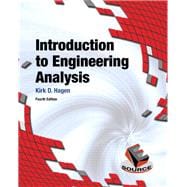
Note: Supplemental materials are not guaranteed with Rental or Used book purchases.
Purchase Benefits
What is included with this book?
1.1 Introduction 1
1.2 Analysis and Engineering Design 4
1.3 Analysis and Engineering Failure 7
Chapter 2 Dimensions and Units 15
2.1 Introduction 15
2.2 Dimensions 16
2.3 Units 20
2.4 SI Units 25
2.5 English Units 32
2.6 Mass and Weight 35
2.7 Unit Conversions 41
Chapter 3 Analysis Methodology 51
3.1 Introduction 51
3.2 Numerical Calculations 52
3.2.1 Approximations 53
3.2.2 Significant Figures 54
3.3 General Analysis Procedure 61
3.4 The Computer as an Analysis Tool 77
3.4.1 Spreadsheets 78
3.4.2 Equation Solvers and Mathematics Software 80
3.4.3 Programming Languages 80
3.4.4 Specialty Software 82
3.4.5 Finite Element Software 82
Chapter 4 Mechanics 91
4.1 Introduction 91
4.2 Scalars and Vectors 94
4.2.1 Vector Operations 96
4.2.2 Vector Components 97
4.2.3 Unit Vectors 99
4.3 Forces 103
4.4 Free-Body Diagrams 110
Procedure for Constructing Free-Body Diagrams 110
4.5 Equilibrium 116
4.6 Stress and Strain 123
4.6.1 Stress 124
4.6.2 Strain 125
4.6.3 Hooke’s Law 126
4.6.4 Stress—Strain Diagram 127
4.7 Design Stress 131
Chapter 5 Electrical Circuits 145
5.1 Introduction 145
5.2 Electric Charge And Current 147
5.3 Voltage 155
5.4 Resistance 158
5.5 Ohm’S Law 162
5.6 Simple DC Circuits 165
5.7 Kirchhoff’s Laws 172
5.7.1 Kirchhoff’s Current Law 172
5.7.2 Kirchhoff’s Voltage Law 173
Chapter 6 Thermodynamics 185
6.1 Introduction 185
6.2 Pressure and Temperature 186
6.2.1 Pressure 187
6.2.2 Temperature 189
6.3 Forms of Energy 193
6.3.1 Potential Energy 194
6.3.2 Kinetic Energy 195
6.3.3 Internal Energy 195
6.3.4 Total Energy 196
6.4 Work and Heat 198
6.4.1 Mechanical Work 199
6.4.2 Heat 203
6.5 The First Law of Thermodynamics 207
6.6 Heat Engines 214
6.7 The Second Law of Thermodynamics 217
Chapter 7 Fluid Mechanics 227
7.1 Introduction 227
7.2 Fluid Properties 230
7.2.1 Density, Specific Weight, and Specific Gravity 230
7.2.2 Bulk Modulus 233
7.2.3 Viscosity 234
7.3 Fluid Statics 239
7.3.1 Pressure—Elevation Relationship 239
7.3.2 Forces on Submerged Surfaces 241
7.4 Flow Rates 243
7.5 Conservation of Mass 246
Chapter 8 Renewable Energy 258
8.1 Introduction 258
8.1.1 Environmental Considerations 260
8.2 Solar 261
8.2.1 Solar Energy Systems 262
8.2.2 Photovoltaic Systems 265
8.3 Wind 274
8.3.1 Basic Energy Analysis of a Horizontal Axis Wind Turbine 278
8.4 Hydro 281
8.4.1 Basic Energy Analysis of a Hydropower Plant 283
8.5 Geothermal 285
8.5.1 Basic Energy Analysis of a Binary Plant 286
8.6 Marine 290
8.6.1 Tidal 290
8.6.2 Ocean 291
8.6.2.2 Ocean Waves 292
8.7 Biomass 296
Chapter 9 Data Analysis: Graphing 302
9.1 Introduction 302
9.2 Collecting and Recording Data 305
9.2.1 Data Identification and Association 305
9.2.2 Accuracy, Precision, and Error 306
9.2.3 Recording Data 310
9.3 General Graphing Procedure 312
9.3.1 Dependent and Independent Variables 314
9.3.2 Variable Ranges 315
9.3.3 Graph Paper 315
9.3.4 Location of Axes 316
9.3.5 Graduation and Calibration of Axes 317
9.3.6 Axis Labels 320
9.3.7 Data Point Plotting 321
9.3.8 Curves 322
9.3.9 Legends and Titles 324
9.3.10 Graphing with Computer Software 324
9.4 Curve Fitting 328
9.4.1 Common Mathematical Functions 329
9.4.2 Method of Selected Points 330
9.4.3 Least Squares Linear Regression 337
9.5 Interpolation and Extrapolation 341
Chapter 10 Data Analysis: Statistics 355
10.1 Introduction 356
10.2 Data Classification and Frequency Distribution 357
Data Classification Guidelines 358
10.3 Measures of Central Tendency 361
10.3.1 Mean 361
10.3.2 Median 362
10.3.3 Mode 365
10.4 Measures of Variation 365
10.5 Normal Distribution 368
Appendix
Index
The New copy of this book will include any supplemental materials advertised. Please check the title of the book to determine if it should include any access cards, study guides, lab manuals, CDs, etc.
The Used, Rental and eBook copies of this book are not guaranteed to include any supplemental materials. Typically, only the book itself is included. This is true even if the title states it includes any access cards, study guides, lab manuals, CDs, etc.